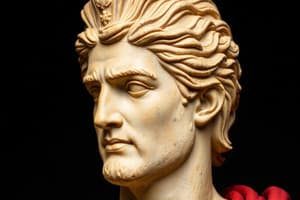Podcast
Questions and Answers
What form of government did Rome transition into after the fall of the last Etruscan king?
What form of government did Rome transition into after the fall of the last Etruscan king?
- Democracy
- Oligarchy
- Monarchy
- Republic (correct)
Who were responsible for protecting the people's rights against abuses of power by the consuls in the Roman Republic?
Who were responsible for protecting the people's rights against abuses of power by the consuls in the Roman Republic?
- Senators
- Tribunes (correct)
- Emperors
- Plebeians
During the Monarchy period of Rome, how many kings ruled before transitioning into a republic?
During the Monarchy period of Rome, how many kings ruled before transitioning into a republic?
- Five kings
- Seven kings (correct)
- Six kings
- Four kings
Which body composed of the city's wealthiest citizens served as an advisory body to the consuls in the Roman Republic?
Which body composed of the city's wealthiest citizens served as an advisory body to the consuls in the Roman Republic?
When did the Roman Empire reach its peak according to the text?
When did the Roman Empire reach its peak according to the text?
What was the title adopted by Octavian, marking the beginning of the Roman Empire?
What was the title adopted by Octavian, marking the beginning of the Roman Empire?
What was the name of the period of relative peace that lasted from 27 BC to AD 180 during the Roman Empire?
What was the name of the period of relative peace that lasted from 27 BC to AD 180 during the Roman Empire?
What was one of the factors that contributed to the expansion of the Roman Empire?
What was one of the factors that contributed to the expansion of the Roman Empire?
Around which century did the decline of the Roman Empire begin?
Around which century did the decline of the Roman Empire begin?
Which of the following was NOT a factor that contributed to the decline of the Roman Empire?
Which of the following was NOT a factor that contributed to the decline of the Roman Empire?
Flashcards are hidden until you start studying
Study Notes
Overview of the Roman Empire
The Roman Empire was one of the most powerful entities known to human history, with its roots dating back to the founding of Rome in 753 BC. This empire underwent significant transformation over centuries before reaching its peak around AD 96-180. Its influence extends far beyond its borders, shaping modern society through various aspects such as architecture, governmental structures, languages, laws, religion, and more.
Early History of the Roman Republic
The early history of the Roman Empire can be traced back to the legendary foundation of the city by Romulus and Remus in 753 BC. The period from 753 BC to 509 BC is known as the Monarchy, during which seven kings ruled. After the fall of the last Etruscan king, Rome transitioned into a republican form of government in 509 BC, ushering in the era of the Roman Republic.
Structure of the Roman Republic
The Roman Republic followed a unique system of government where executive power rested solely with two consuls elected annually who held all legislative, executive, and judicial authority. In addition, there were ten tribunes, also elected yearly, responsible for protecting the people's rights against abuses of power by the consuls and other magistrates. The Senate, composed of the city's wealthiest citizens, served as an advisory body to the consuls and had significant influence over the republic's military and foreign policy.
Transition to the Roman Empire
The Roman Republic lasted for over 500 years before transitioning into the Roman Empire in 27 BC. This change was marked by the end of the Roman Civil War, which saw the last Roman consul, Gaius Octavius Thurinus, also known as Octavian, emerging as the sole ruler of Rome. Octavian adopted the title Augustus, and his reign is considered the beginning of the Roman Empire.
Augustus and the Pax Romana
Augustus's rule was characterized by a period of relative peace known as the Pax Romana, which lasted from 27 BC to AD 180. During this time, the empire experienced significant growth and expansion, both in terms of territory and population.
Expansion of the Roman Empire
The Roman Empire expanded rapidly, with its territorial reach stretching from the Atlantic Ocean to the Persian Gulf, and from the Black Sea to the Sahara Desert. This expansion was driven by a combination of factors, including military conquest, diplomatic alliances, and the adoption of Roman culture by conquered peoples.
Collapse of the Roman Empire
The Roman Empire began to decline around the third century AD, following a period of political instability and military crises. This decline was exacerbated by economic difficulties, invasions by barbarian tribes, and the rise of Christianity, which eventually replaced the traditional Roman religion.
In conclusion, the Roman Empire was a powerful and influential entity that shaped much of the Western world's culture, government, and societal structures. Its history is marked by periods of prosperity and expansion, as well as decline and fall, leaving a lasting impact on human history.
Studying That Suits You
Use AI to generate personalized quizzes and flashcards to suit your learning preferences.




